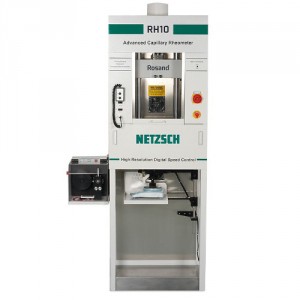Rosand RH7 / RH 10 Robust research capillary rheometers for high force conditions.
To find out more details, please fill in the request form below.
Ask for more information
+40 21 255 31 32
Robust research capillary rheometers for high force conditions.
Used in hundreds of research laboratories around the world, the robust ‘H’ frame design of Rosand RH7 and RH10 floor standing capillary rheometers allows operation under ultra-high loading conditions, as well as providing optimized space for multiple accessory configurations.
Features and benefits
Research-level Rosand RH7 and RH10 capillary rheometers provide highly flexible measurement capabilities for materials under high pressure and high shear rate extrusion - from polymer melts to ceramics, and from foodstuffs to inks and coatings.
- High force range (up to 100kN) and wide dynamic speed range (>225,000:1) allow test correlation with real material processing conditions.
- Twin bore barrels as standard enable absolute shear viscosity measurements and simultaneous calculation of extensional (elongational) viscosity.
- Range of optional barrel sizes and barrel materials to permit measurement of thermally-sensitive, chemically-aggressive or aqueous-based samples.
- Wide range of high precision tungsten carbide dies as standard to cover all materials and test types.
- Easily interchangeable melt pressure transducers to cover all test requirements – configured with low noise, triple-stage amplifiers for optimized measurement sensitivity at the die entry when using ‘zero length’ dies (extensional viscosity measurements).
- Nitrogen purge option available for testing in a dry, inert atmosphere to minimize sample degradation.
- Integral fume chamber with extraction to vent sample gases for operator safety.
- Proprietary bi-modal speed control algorithms suited to low and high speed operation optimize shear rate measurement range for a particular die.
- Precise sample temperature control using three independent zone heaters, with 10 times DIN accuracy platinum resistance thermometers. High temperature (500ºC maximum) and cooling coil options also available.
- Rigid ‘H’ frame design for compliance-free measurements in transient tests such as pVT determination.
- Open design below barrel exit to accommodate optional accessories such as die swell measurements, melt cutters, slot die system and melt strength (Haul Off).
- Easy to use Flowmaster software with full range of tests and analyses for shear and extensional viscosity, as well as determining sample stability, wall slip and melt fracture.
Key applications
- Characterization of polymer or suspension rheology across a range of shear rates and temperatures
- Simulation of extensional viscosity dominated processes such as fibre spinning, blow moulding, film blowing and thermoforming
- Assessment of extrusion behaviour for processes such as injection moulding and hot melt extrusion
- Evaluation of material behaviour at process relevant shear rates such as high speed coating and printing applications
- Detection of polymer instabilities such as melt fracture and thermal degradation
- Measurement of material elasticity and related properties such as die swell
Industry applications:
- Polymers
- Coatings
- Cermics
- Metals
- Pharmaceuticals
- Sealants
- Foods
- Inks
How it works
The Rosand RH7 and RH10 capillary rheometer systems enable controlled extrusion (by volumetric flow) of a sample through a high precision die of known dimensions, to characterize material flow properties typically under conditions of high force (or pressure) and/or high shear rate. Using a twin bore barrel and a ‘zero length’ die configuration allows simultaneous determination of shear viscosity and extensional (elongational) viscosity as a function of shear (or deformation) rate.
A capillary rheometer system comprises several key components to enable robust, reliable and accessible rheological measurements for a particular sample or application:
- Capillary rheometer base unit. Includes the barrel with bores to load the sample – the bore diameter and barrel material must be compatible with the material(s) under test. The base unit also includes a head unit, which has a mechanical connection to the pistons which are used to extrude the sample. Key system functions of drive force and piston speed range are controlled by the base unit.
- Die and pressure transducer combination. The die is mounted at the bottom of the barrel bore, and its dimensions define the applied shear field. A melt pressure transducer is mounted in the barrel to measure the resultant pressure at the die entrance as the material is extruded. The die dimensions and pressure transducer range must be appropriate to the sample type and test under consideration.
- Temperature and/or environmental control options. Accurate control of barrel temperature is essential since rheological properties are a strong function of temperature. For thermally-sensitive materials, thermal equilibrium times and inert test environments are critical considerations to ensure reliable data.
- Instrument software. Rheological testing can be, by its nature, relatively complex to set up. The Rosand Flowmaster software interface is designed for simplicity and ease-of use with intuitive test set-up methodology in conjunction with a ‘live’ instrument graphic at run time reporting all key test and measurement parameters.


